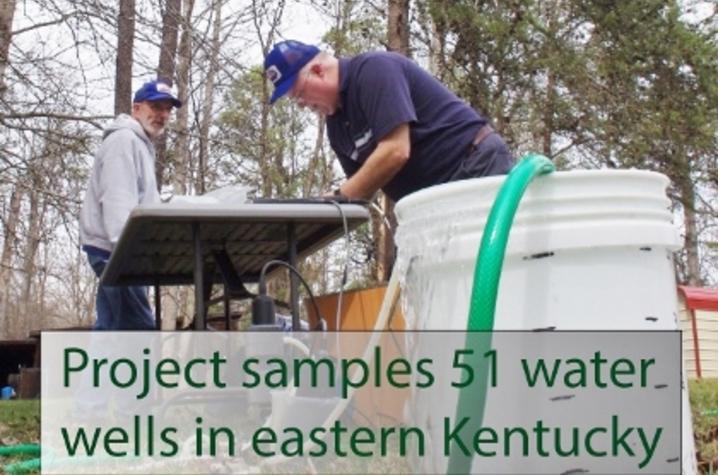Groundwater-quality Sampling in the Berea Sandstone and Rogersville Oil and Gas Plays
LEXINGTON, Ky. (June 20, 2016) — The prospect of increasing oil and gas exploration in Kentucky has caught public attention and generated many news stories in recent months. It has also prompted new research projects by the Kentucky Geological Survey (KGS) and its research partners. The most recent project, being conducted in collaboration with GSI Environmental Inc., of Austin, Texas, and funded by the U.S. Department of Energy’s Research Partnership to Secure Energy for America program, is sampling 51 water wells in the Berea and Rogersville oil and gas plays in Eastern Kentucky to help gather baseline information on groundwater chemistry.
Environmental groups and some in the general public have expressed concern that the use of horizontal drilling and hydraulic fracturing techniques in the study area (Greenup, Carter, Boyd, Lawrence, Elliot, and Johnson Counties) could have an impact on groundwater supplies in the region, especially shallow aquifers used by some for household and agricultural use. Analyzing well-water samples for levels of major ions and cations, metals, and dissolved gases (including methane) will help characterize existing groundwater quality in the area and help state and federal water-resource managers identify and monitor potential changes in groundwater-quality conditions and address the public’s environmental concerns.
After first identifying and locating potential sampling sites in the study area using available water-well records stored in the Kentucky Groundwater Data Repository, KGS Water Resources staff began the task of contacting property owners for permission to access their wells, often with the help of the UK Agricultural Cooperative Extension Office. Then water samples were collected using scientific protocols being designed and tested nationally. Detailed information about water-well construction and site-specific conditions was also collected at the time of sampling, and collected samples were delivered to the KGS water lab and two contract analytical laboratories for analysis of organic and inorganic chemicals.
“The major objective of this project is to obtain a preliminary understanding of groundwater chemistry in the study region, as well as its spatial variability throughout the area,” according to the KGS principal investigator, Junfeng Zhu, of the Survey’s Water Resources Section. “The project also intends to use isotope data to help evaluate possible sources of methane detected in the groundwater. Results from this study can be used as a reference to infer potential impacts of future horizontal drilling and hydraulic fracturing on groundwater quality.”
All field sampling and laboratory analysis scheduled for the project have been completed, and interpretation of the groundwater chemistry data is presently underway. Preliminary results indicate that methane may be a fairly common constituent of groundwater in Eastern Kentucky: 41 of 51 sampled wells had detectable concentrations of methane, and 26 of the sampled wells had methane concentrations above 1 milligram per liter. Analysis of carbon and hydrogen isotopes associated with methane in the water samples indicates that in most of the sampled wells the gas is generated from microbial activity, suggesting a shallow origin of depth not directly associated with oil or gas extraction. A detailed evaluation and analysis of these data will continue until mid to late summer, and a report on the findings will be prepared and published later this year.
UK is the University for Kentucky. At UK, we are educating more students, treating more patients with complex illnesses and conducting more research and service than at any time in our 150-year history. To read more about the UK story and how you can support continued investment in your university and the Commonwealth, visit uky.edu/uk4ky. #uk4ky #seeblue
MEDIA CONTACT: Whitney Harder,859-323-2396, whitney.harder@uky.edu







